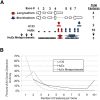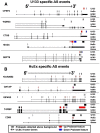SplicerEX: a tool for the automated detection and classification of mRNA changes from conventional and splice-sensitive microarray expression data
- PMID: 22736799
- PMCID: PMC3404365
- DOI: 10.1261/rna.033621.112
SplicerEX: a tool for the automated detection and classification of mRNA changes from conventional and splice-sensitive microarray expression data
Abstract
The key postulate that one gene encodes one protein has been overhauled with the discovery that one gene can generate multiple RNA transcripts through alternative mRNA processing. In this study, we describe SplicerEX, a novel and uniquely motivated algorithm designed for experimental biologists that (1) detects widespread changes in mRNA isoforms from both conventional and splice sensitive microarray data, (2) automatically categorizes mechanistic changes in mRNA processing, and (3) mitigates known technological artifacts of exon array-based detection of alternative splicing resulting from 5' and 3' signal attenuation, background detection limits, and saturation of probe set signal intensity. In this study, we used SplicerEX to compare conventional and exon-based Affymetrix microarray data in a model of EBV transformation of primary human B cells. We demonstrated superior detection of 3'-located changes in mRNA processing by the Affymetrix U133 GeneChip relative to the Human Exon Array. SplicerEX-identified exon-level changes in the EBV infection model were confirmed by RT-PCR and revealed a novel set of EBV-regulated mRNA isoform changes in caspases 6, 7, and 8. Finally, SplicerEX as compared with MiDAS analysis of publicly available microarray data provided more efficiently categorized mRNA isoform changes with a significantly higher proportion of hits supported by previously annotated alternative processing events. Therefore, SplicerEX provides an important tool for the biologist interested in studying changes in mRNA isoform usage from conventional or splice-sensitive microarray platforms, especially considering the expansive amount of archival microarray data generated over the past decade. SplicerEX is freely available upon request.
Figures






Similar articles
-
Epstein-Barr virus induces global changes in cellular mRNA isoform usage that are important for the maintenance of latency.J Virol. 2013 Nov;87(22):12291-301. doi: 10.1128/JVI.02464-13. Epub 2013 Sep 11. J Virol. 2013. PMID: 24027308 Free PMC article.
-
Comparison of Affymetrix Gene Array with the Exon Array shows potential application for detection of transcript isoform variation.BMC Genomics. 2009 Nov 12;10:519. doi: 10.1186/1471-2164-10-519. BMC Genomics. 2009. PMID: 19909511 Free PMC article.
-
SplicerAV: a tool for mining microarray expression data for changes in RNA processing.BMC Bioinformatics. 2010 Feb 25;11:108. doi: 10.1186/1471-2105-11-108. BMC Bioinformatics. 2010. PMID: 20184770 Free PMC article.
-
Nuclear receptors and their role in Epstein -- Barr virus induced B cell transformation.Exp Oncol. 2009 Jun;31(2):67-73. Exp Oncol. 2009. PMID: 19550394 Review.
-
Methods for quantitation of gene expression.Front Biosci (Landmark Ed). 2009 Jan 1;14(2):552-69. doi: 10.2741/3262. Front Biosci (Landmark Ed). 2009. PMID: 19273085 Review.
Cited by
-
Alternative RNA Splicing as a Potential Major Source of Untapped Molecular Targets in Precision Oncology and Cancer Disparities.Clin Cancer Res. 2019 May 15;25(10):2963-2968. doi: 10.1158/1078-0432.CCR-18-2445. Epub 2019 Feb 12. Clin Cancer Res. 2019. PMID: 30755441 Free PMC article.
-
Epstein-Barr virus induces global changes in cellular mRNA isoform usage that are important for the maintenance of latency.J Virol. 2013 Nov;87(22):12291-301. doi: 10.1128/JVI.02464-13. Epub 2013 Sep 11. J Virol. 2013. PMID: 24027308 Free PMC article.
References
-
- Affymetrix. 2005. Alternative transcript analysis methods for exon arrays. Affymetrix Whitepaper 2005. http://www.affymetrix.com/support/technical/whitepapers.affx.
-
- Blencowe BJ 2006. Alternative splicing: New insights from global analyses. Cell 126: 37–47 - PubMed
Publication types
MeSH terms
Substances
Grants and funding
LinkOut - more resources
Full Text Sources
Other Literature Sources
Molecular Biology Databases
Miscellaneous
